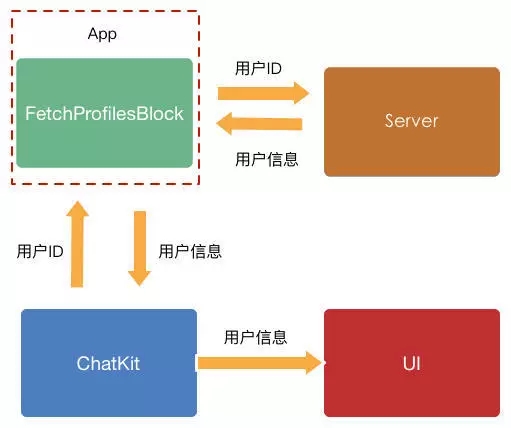有一種Block叫Callback,有一種Callback叫CompletionHandler
【引言】iOS10推送部分的API,大量使用了 CompletionHandler 這種命名方式,那么本文我們將對比下這種 Block 的特殊性,以便更好的理解和在自己的項目中實踐 CompletionHandler 樣式的 Blcok。
正文
我們作為開發者去集成一個 Lib (也可以叫輪子、SDK、下文統一叫 Lib)時,我們會發現我們遇到的 Block, 按照功能的角度劃分,其實可以分為這幾種:
- Lib 通知開發者,Lib操作已經完成。一般命名為 Callback
- 開發者通知 Lib,開發者的操作已經完成。一般可以命名為 CompletionHandler。
這兩處的區別: 前者是 “Block 的執行”,后者是 “Block 的填充”。
Callback vs CompletionHandler 命名與功能的差別,Apple 也沒有明確的編碼規范指出過,只不過如果按照“執行與填充”的功能劃分的話,callback 與 completionHandler 的命名可以區分開來對待。同時也方便調用者理解 block 的功能。但總體來說,Apple 官方的命名中,“Block 填充“這個功能一般都會命名為 “completionHandler”,“Block 執行”這個功能大多命名為了“callback” ,也有少部分命名為了 “completionHandler”。
比如:
NSURLSession 中,下面的函數將 “callback” 命名為了 “completionHandler”:
- - (NSURLSessionDataTask *)dataTaskWithURL:(NSURL *)url completionHandler:(void (^)(NSData * _Nullable data, NSURLResponse * _Nullable response, NSError * _Nullable error))completionHandler;
我們常常見到 CompletionHandler 被用到了***種場景,而***種場景“Block 執行”命名為 Callback 則更合適。
不是所有 Block 都適合叫做 CompletionHandler
一般情況下,CompletionHandler 的設計往往考慮到多線程操作,于是,你就完全可以異步操作,然后在線程結束時執行該 CompletionHandler,下文的例子中會講述下 CompletionHandler 方式在多線程場景下的一些優勢。
CompletionHandler + Delegate 組合
在 iOS10 中新增加的 UserNotificaitons 中大量使用了這種 Block,比如:
- - (void)userNotificationCenter:(UNUserNotificationCenter *)center
- didReceiveNotificationResponse:(UNNotificationResponse *)response
- withCompletionHandler:(void (^)(void))completionHandler;
文檔 對 completionHandler 的注釋是這樣的:
- The block to execute when you have finished processing the user’s response. You must execute this block from your method and should call it as quickly as possible. The block has no return value or parameters.
同樣在這里也有應用:
- - (void)URLSession:(NSURLSession *)session task:(NSURLSessionTask *)task
- didReceiveChallenge:(NSURLAuthenticationChallenge *)challenge
- completionHandler:(void (^)(NSURLSessionAuthChallengeDisposition disposition, NSURLCredential * __nullable credential))completionHandler;
還有另外一個也非常普遍的例子(Delegate 方式使用URLSession 時候必不可少的 4個代理函數之一 )
- - (void)URLSession:(NSURLSession *)session dataTask:(NSURLSessionDataTask *)dataTask
- didReceiveResponse:(NSURLResponse *)response
- completionHandler:(void (^)(NSURLSessionResponseDisposition disposition))completionHandler;
在代理方法實現代碼里面,若是不執行 completionHandler(NSURLSessionResponseAllow) 話,http請求就終止了。
CompletionHandler + Block 組合
函數中將函數作為參數或者返回值,就叫做高階函數。
按照這種定義,Block 中將 Block 作為參數,這也就是高階函數。
結合實際的應用場景來看一個例子:
如果有這樣一個需求:
拿我之前的一個 IM 項目 ChatKit-OC (開源的,下面簡稱 ChatKit)為例,當你的應用想要集成一個 IM 服務時,可能這時候,你的 APP 已經上架了,已經有自己的注冊、登錄等流程了。用 ChatKit 進行聊天很簡單,只需要給 ChatKit 一個 id 就夠了。聊天是正常了,但是雙方只能看到一個id,這樣體驗很不好。但是如何展示頭像、昵稱呢?于是就設計了這樣一個接口,-setFetchProfilesBlock: 。
這是上層(APP)提供用戶信息的 Block,由于 ChatKit 并不關心業務邏輯信息,比如用戶昵稱,用戶頭像等。用戶可以通過 ChatKit 單例向 ChatKit 注入一個用戶信息內容提供 Block,通過這個用戶信息提供 Block,ChatKit 才能夠正確的進行業務邏輯數據的繪制。
示意圖如下:
具體實現如下:
方法定義如下:
- /*!
- * @brief The block to execute with the users' information for the userIds. Always execute this block at some point when fetching profiles completes on main thread. Specify users' information how you want ChatKit to show.
- * @attention If you fetch users fails, you should reture nil, meanwhile, give the error reason.
- */
- typedef void(^LCCKFetchProfilesCompletionHandler)(NSArray> *users, NSError *error);
- /*!
- * @brief When LeanCloudChatKit wants to fetch profiles, this block will be invoked.
- * @param userIds User ids
- * @param completionHandler The block to execute with the users' information for the userIds. Always execute this block at some point during your implementation of this method on main thread. Specify users' information how you want ChatKit to show.
- */
- typedef void(^LCCKFetchProfilesBlock)(NSArray *userIds, LCCKFetchProfilesCompletionHandler completionHandler);
- @property (nonatomic, copy) LCCKFetchProfilesBlock fetchProfilesBlock;
- /*!
- * @brief Add the ablitity to fetch profiles.
- * @attention You must get peer information by peer id with a synchronous implementation.
- * If implemeted, this block will be invoked automatically by LeanCloudChatKit for fetching peer profile.
- */
- - (void)setFetchProfilesBlock:(LCCKFetchProfilesBlock)fetchProfilesBlock;
用法如下所示:
- #warning 注意:setFetchProfilesBlock 方法必須實現,如果不實現,ChatKit將無法顯示用戶頭像、用戶昵稱。以下方法循環模擬了通過 userIds 同步查詢 users 信息的過程,這里需要替換為 App 的 API 同步查詢
- [[LCChatKit sharedInstance] setFetchProfilesBlock:^(NSArray *userIds,
- LCCKFetchProfilesCompletionHandler completionHandler) {
- if (userIds.count == 0) {
- NSInteger code = 0;
- NSString *errorReasonText = @"User ids is nil";
- NSDictionary *errorInfo = @{
- @"code":@(code),
- NSLocalizedDescriptionKey : errorReasonText,
- };
- NSError *error = [NSError errorWithDomain:NSStringFromClass([self class])
- code:code
- userInfo:errorInfo];
- !completionHandler ?: completionHandler(nil, error);
- return;
- }
- NSMutableArray *users = [NSMutableArray arrayWithCapacity:userIds.count];
- #warning 注意:以下方法循環模擬了通過 userIds 同步查詢 users 信息的過程,這里需要替換為 App 的 API 同步查詢
- [userIds enumerateObjectsUsingBlock:^(NSString *_Nonnull clientId, NSUInteger idx,
- BOOL *_Nonnull stop) {
- NSPredicate *predicate = [NSPredicate predicateWithFormat:@"peerId like %@", clientId];
- //這里的LCCKContactProfiles,LCCKProfileKeyPeerId都為事先的宏定義,
- NSArray *searchedUsers = [LCCKContactProfiles filteredArrayUsingPredicate:predicate];
- if (searchedUsers.count > 0) {
- NSDictionary *user = searchedUsers[0];
- NSURL *avatarURL = [NSURL URLWithString:user[LCCKProfileKeyAvatarURL]];
- LCCKUser *user_ = [LCCKUser userWithUserId:user[LCCKProfileKeyPeerId]
- name:user[LCCKProfileKeyName]
- avatarURL:avatarURL
- clientId:clientId];
- [users addObject:user_];
- } else {
- //注意:如果網絡請求失敗,請至少提供 ClientId!
- LCCKUser *user_ = [LCCKUser userWithClientId:clientId];
- [users addObject:user_];
- }
- }];
- // 模擬網絡延時,3秒
- // sleep(3);
- #warning 重要:completionHandler 這個 Bock 必須執行,需要在你**獲取到用戶信息結束**后,將信息傳給該Block!
- !completionHandler ?: completionHandler([users copy], nil);
- }];
對于以上 Fetch 方法的這種應用場景,其實用方法的返回值也可以實現,但是與 CompletionHandler 相比,無法自由切換線程是個弊端。
































